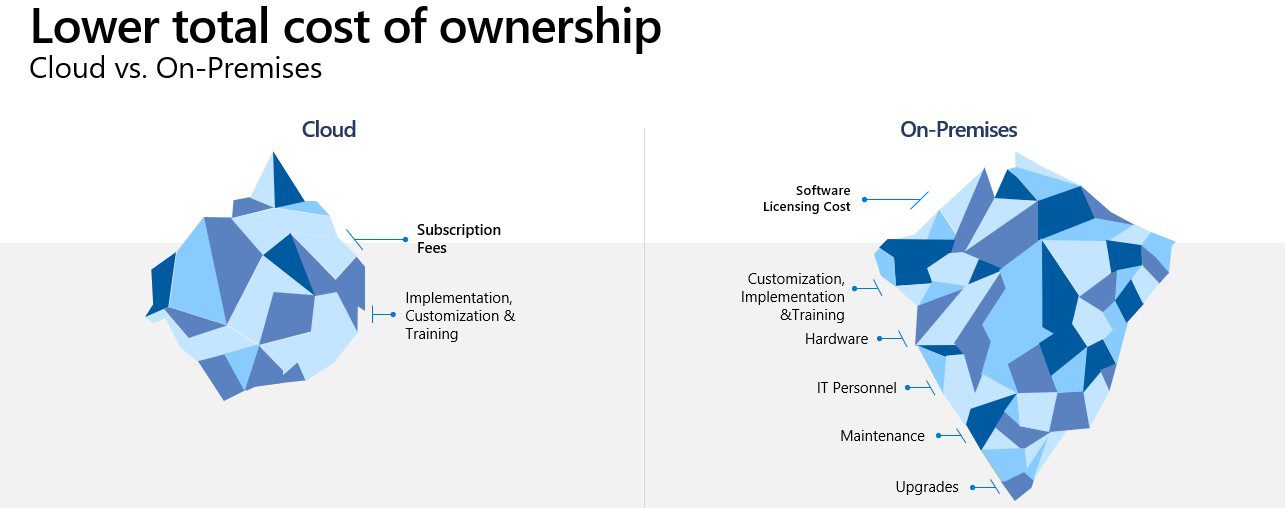Has your perception of the cloud kept up with advancements in technology? Economic and logistic disruptions from COVID-19 have compelled most organizations to reassess whether their legacy systems can deliver on modern goals and priorities. While shifting market conditions have accelerated cloud adoption, some are still weighing the benefits. These businesses have allowed on-premises nostalgia to take hold and determine their cloud strategy.
Don’t allow misconceptions to dictate your journey. Get expert help through the Microsoft Dynamics 365 migration program to move from Dynamics AX or Dynamics CRM to Dynamics 365.
Addressing misconceptions about cloud migration
Moving to the cloud is no small decision. Dynamics 365 on-premises customers historically point to cost, timing, and complexity as reasons to delay or not to migrate. Cloud innovation and process advancements will only continue to erode these inaction arguments, further widening the gap with on-premises solutions.
Cost is always a decision factor. Are the benefits gained greater than the expense? Migrating, like anything, requires funding and resources. However, the hidden costs of remaining on-premises and maintaining your current solution are growing. Consider the graveyard of customizations you’ve built over the years that are no longer in use. Organizations need to weigh the total cost of ownership—infrastructure costs, support costs, and upgrade costs—to make a true cloud and on-premises comparison.


Migrating to the cloud should be a business priority. While customizations and data can make the process time-consuming, few business investments can provide similar efficiency gains. Microsoft engineered the On-Premises to Online Migration Factory to help Dynamics CRM customers. This end-to-end migration process provides a guided way to move on-premises instances without the need of reimporting the data—thus reducing time and costs.


Customizations often hold on-premises systems together, allowing to adequately function in our modern environment. This can make knowing how to untangle your solution or what to migrate difficult. The Dynamics 365 migration program offers technical assessments to guide our Dynamics AX and Dynamics CRM customers through this process. Want to identify organization-specific benefits or optimize the transition process? Our Standard Migration Assessment can help you identify goals, understand migration benefits, and reduce outlay as you transition.
Adding value with Dynamics 365
The gap between on-premises and the cloud solutions is growing, and there’s a good reason. Innovation among cloud now outpaces on-premises development. With end-of-support dates nearing, this gap will only continue to grow, limiting productivity gains and configurability an organization might see with Power Apps, Power Automate, or Power BI functionality. Data centralized in one source only enhances the potential. Knowing usage patterns, adoption rates, and performance metrics, we can continuously update the cloud service without significant business disruption. When it comes to providing updates, Microsoft’s priority is the cloud because it’s the most efficient way to innovate, ideate, and provide value to customers. Customers no longer need to:
- Host and secure software
- Build a data center
- Handle identity management
- Manage connections to other systems
Instead, the cloud platform empowers an out-of-the-box mentality that allows users to get started with no expertise or additional tools.
The cloud is the future
As businesses continue to prioritize remote work and collaboration, the cloud will continue to be the fiber that connects employees, systems, and resources regardless of time zone. Reducing your physical footprint today is a great way to reduce costs and prepare for tomorrow. Migrating to Dynamics 365 will ensure your organization is prepared to meet future needs and challenges. To see how other companies have made this transition, visit our Dynamics 365 migration community.






